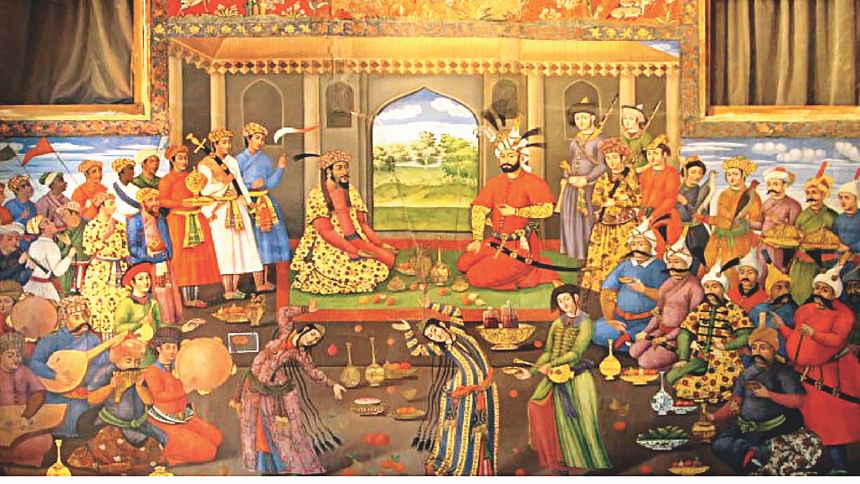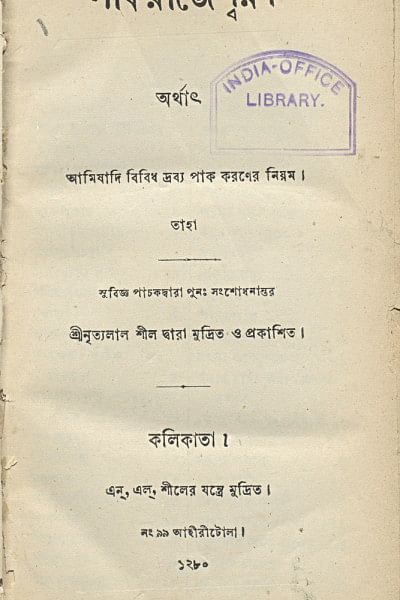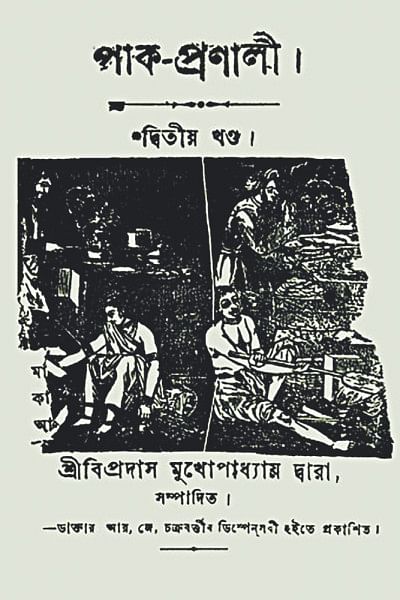A brief introduction to BENGAL'S GASTRONOMIC HISTORY

What distinctly separated Bengal from most of the other regions of India was the generous endowment of nature, nurtured and sustained by the mighty rivers flowing down the Himalayas into the Bay of Bengal. The tapestry of rivers, their tributaries and, most importantly, the rotation of the six seasons, of which Barsha (monsoon) recreated and shaped life – providing a cradle of lush greenery, where a variety of fish, rice and vegetables thrived in abundance and where the production and trade in the finest cotton textiles (Muslin) flourished.
The bounty of the land and the innumerable riverine tracts attracted explorers and traders to the region. The nomads who arrived from Central Asia, the Persians, Arabs, Turks and Europeans, all left behind an indelible mark as "cross-pollinators" of Bengal's gastronomy and culture. Bengal was known as the granary of the Mughal empire, and fed its people well all year round. Francois Bernier (1600 AD), a French traveller to Bengal, testified that, "Bengal abounds with every necessity of life," and created a proverb which says, "The kingdom of Bengal had a hundred gates open for entrance, but not one for departure."

There is not enough documentation on food culture and habits prior to the 12th century. The literature and religious texts and treaties of the middle ages of Bengal, and the folklore that evolved around the social lifestyle of the people, provide an interesting narrative of the food habits of the people, and reflections on social diversity and norms. The Mangalkavyas of the middle ages, and the legend of Chandsawdagar the spice trader (Gandha Banik) carrying descriptions of food offerings at the wedding of Behula, bear an interesting testament of what people ate in Bengal and the seasonal festivities surrounding the life and living conditions of the people. However, what is known about the diet of the people is that it consisted of rice as the staple, and various kinds of fish and leafy or other types of vegetables such as pumpkins, tubers, bitter gourds, green plantains, water reeds, lotus roots and stems, sugarcane, jaggery, coconuts and fruits like banana, jackfruits and tamarind (the origin of the English word "tamarind" came from the Arabic "thamari-i-hind" or fruit of India), to name a few.
Ghee with steaming hot rice was a common dish and continues to be savoured, while meat, especially cow's meat, was not very popular because of strict Hindu religious edicts. However, it is established that prohibitions on consuming meat came from the Aryan resistance to taking life for food with specific reference to cows or cattle and it came to be inviolable among Hindus much later, with vegetarianism taking root. K.T. Achaya, in his monumental research work on food history of India, draws interesting references to meat dishes and meat cooked with rice from the Mahabharata and other ancient scriptures. One can assume that the notion of the 'Sacred Cow' came long after the Mahabharata and the Arthashastra were written. Like elsewhere in India, diet was profoundly connected to health issues, as is evident from the Ayurveda, the ancient Indian system of wellness and balance, imparting the stimulating (rajasik), calming (saatvik) and sedating (tamasik) effects of food, including prescriptions for disciplined eating. Even the sequence of eating meals was determined on health considerations. Perhaps, it is only in the Indian sub-continent that such rigorous discussion on the philosophy of food and eating has been so evident. The age-old adage, "You are what you eat, you eat what you are," surfaces very prominently where food is considered a "marker of identity" and not only a means of sustenance.
Regarding preparation methods (recipes), little is available in early philosophical or medical texts and it was only in 1831 that the first printed cookbook in vernacular "Pakrajeswar" was published by the Maharaja of the princely state of Burdwan. The book carried the culinary traditions of medieval India and that of the Mughals under Shah Jahan, largely dealing in meat dishes with very little use of onion and garlic. This was followed by another cookbook "Byanjan Ratnakar" and in 1923 "Pak Pronali", by Bipradas Mukhopadhyay. In 1930, Muslim "Pak-Pranali" was published by Syeda Hafeza Khatun. These are the earliest known recipe books in Bengali language.
Women's engagement in cooking and associated rituals, driven by religion and cultural norms, occupy another insightful chapter in the history of food in Bengal. Women who could cook well were praised and compared to Draupadi, wife of the Pandava brothers in the Mahabharata, who is said to have possessed good culinary knowledge. The Kama Sutra, which is mostly known as a book of sixty-four sexual positions, also extensively delves in the preparation of food that function as aphrodisiacs. Besides, there were many customs and rituals sanctioned by religion that a woman had to perform, governing the idea of purification before entering the kitchen. They could not consume certain foods, and followed rituals of fasting during lunar and solar eclipse. The restrictions imposed on women's diet forced them to seek their own nutritional supplements, especially the Hindu widows, which led them to improvise vegetable recipes that are even savoured today, and fall under the repertoire of typical Bengali cuisine. These would include pastes of vegetable skins prepared with black cumin, mustard, chili, fried and mashed leafy vegetables and roots, banana flowers etc. The most commonly heard of vegetarian dish from medieval time was Shukto, a bittersweet preparation made with dried leaves of edible plants, and which now carries variations with different vegetables like gourd, to impart a mild bitter taste. Hindu widows were required to maintain the most rigorous vegetarian regime and were restricted from taking any food items and spices that were considered "detrimental to celibacy." However, even though religious edicts did not affect women bearing Muslim identity or Hindus of the lower castes in terms of their choice of food, cultural norms did. Thus, gender in food constitutes another important chapter in the gastronomic history of Bengal.

When it came to the basic diet of fish and rice (Mache Bhate Bangali), no marked difference across religious profiles prevailed and, unlike the upper caste Hindu priests from other regions of India, the strict vegetarians -- the Brahmins from Bengal, compromised vegetarianism by adding to their repertoire of diet white scaled fish, a widely available source of protein. They referred to such fish as the "the fruits of the river." Chitrita Banerji, famous food historian, notes that fish was and has remained not only a source of food but also considered "a symbol of prosperity and fertility and touches many aspects of ceremonial and ritual life in Bengal." The Buddhists, however, stuck to their vegetarian conviction. Offering food to the gods is an age-old ritual that is still in practice. Till the beginning of the middle ages, however, there remained a resistance to offering food to gods which were not considered indigenous, and therefore impure for the offering. All these further go on to accentuate the importance of religion in people's engagement with food.
The visitors to India introduced many edibles which went on to further enhance and exude the key elements of prepared dishes, adding flavour, body and texture. Many of the spices and vegetables that are used in our daily cooking in Bengal today were introduced by visitors. Of significance are vegetables like green chillies, tomatoes, potatoes and cauliflower. Potatoes, the widely used vegetables, came to be popular after the 1800s. Lentils in Bengali diet as a protein substitute was also a later introduction and no reference of it was found in ancient Bengali literature, as stated by several food historians. Garlic and onions, two other essential ingredients, were said to have arrived from South West Asia and Afghanistan and took a long while to enter the Bengali Hindu kitchen. Resistance to the use of garlic and onions still exists to a certain extent among several non-Muslim communities. However, according to Colleen Taylor Sen, an eminent historian, traces of garlic, ginger and turmeric -- the key ingredients of curry, were found in the clay pots of the Indus valley civilisation and the "proto-curry." In fact, it was eaten long before Arabs, Indians and Europeans plied the oceans in the past thousand years. The term "curry" is derived from the word "Kari" meaning sauce in Tamil.
The contribution of the Muslims in enriching the culinary repertoire of India has drawn considerable attention of food historians. The Turks occupied Bengal in 1204 AD and by 17th century, Dhaka's prominence as the provincial capital of the Moghul empire saw the infiltration of the Persian and Middle Eastern culture, and rich aromatic foods blended with spices brought in by the visitors. An assortment of Mughal cuisine entered the kitchen of the affluent in largely Muslim households, and meat preparations came into prominence. Biriyani, polao, charcoal grilled kebabs, meat dishes with thick aromatic sauces and sweets (halwa) with a variety of nuts, raisins, saffron and rosewater, deserve special mention. Here, credit must be given to the Awadhi cooks who travelled with Wazir Ali Shah after he was deposed from Oudh and settled in Garden Reach, Kolkata. These cooks contributed significantly in stretching the boundaries of Mughal cuisine in Bengal, somewhat differently from the North Indian variations. India's inheritance from the Mughal kitchen has been profound, and Muslims influenced both the "style and substance of Indian food."

When it comes to sweet dishes, payesh and kheer made with evaporated milk were the common favourites, and there is no documented evidence of making chana, the main protagonist of sweets like rasogollah, pantua, sandesh etc., anywhere in India before the 18th century. Deliberately curdling milk of the "Sacred Cow" was considered a sin among the Hindus. The Portuguese, with their predilection for cheese, introduced the process of making cottage cheese (chana) by curdling milk, thus breaking the Hindu religious taboo. Interestingly, this taboo was broken only in Bengal and not in other places where the Portuguese also had their presence. Perhaps, this could be attributed to the extensive marital alliance that took place in Bengal among the Portuguese and the local inhabitants, mostly from less affluent social order. Chitrita Banerji mentions eminent Bengali scholar, Professor Abdur Razzaq, who believed "there was no midwifery in the birth of these sweets but was devised by sweet makers."
Another significant development in the food scene of urban Bengal was the "Confectionary Renaissance" that took place while Kolkata and Dhaka evolved as centres of trade and commerce. The Baghdadi Jew, the Portuguese and the French settlers were known as masters of bakery, and the British introduced tea, which, until the 1850s, did not have a mass appeal in India. Simultaneously, a new breed of Bengalis, well endowed with English education, indulged in emulating European culture and their food habits. Chops, cutlets (originating from the French word côtelette), bread, cakes, custard puddings etc., accompanied with tea, came to be the urban Bengali's leisurely indulgence and intellectual stimulants.
To conclude, one may say that there are many routes to approach the history of a nation or region. Bengal's engagement with food traverses many historical and social circumstances, which provides a good understanding of the important landmarks of history of this region. This is just a brief abstract of Bengal's gastronomic journey. Karl Popper, a great philosopher of our time, once said, "There is no history of mankind, there are only many histories of all kinds of aspects of human life."
Amer Wahab is a market research consultant with interest in history and politics.

 For all latest news, follow The Daily Star's Google News channel.
For all latest news, follow The Daily Star's Google News channel. 



Comments